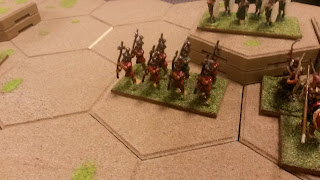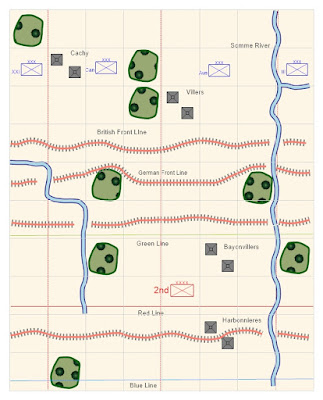The briefings and setup can be read in my earlier
post from last week.
We assembled a fair amount of kit for the game, many thanks to John and Tim for the loan of tanks, artillery, aircraft and airfields. We played it predominantly using my 20mm stuff, although the artillery was supplemented with some 15mm pieces, and the aircraft were all 1/144th Wings of war planes.
View from the German side. The Canadians have brown tanks and the Australians green ones to make recognition easier. The French were supported by a battalion of Whippets, and John produced his magnificent 20mm Whippet carved from wood! Each tank model represents around 40 real vehicles, and each square is around 2km (giving each Corps an assault frontage of around 6km).
The British command team. Dimly visible in the far right is the Allied airfield, packed with aircraft. John took the role of Rawlinson, 4th Army commander, Tim the Australians, Robert the Canadians and Jerry the RFC.
View from the British lines. Each of the assaulting divisions has eight stands of infantry, split into two waves of four each. For ease of recognition the Canadians had Lewis guns and the Australians had Vickers guns. The Cavalry divisions each have four stands of mounted infantry and a Whippet or Armoured Car attached. III Corps on the far left was represented by a single tank and a few stands of infantry.
Allied reserve artillery waiting to be deployed. Each field gun represents about 100 pieces, while the heavy guns are around 50 guns each. Plus about a million rounds of ammunition.... 4th Army commander decided to split the reserve field guns evenly, but allocated the bulk of the heavy guns to the Australians. In return, the Canadians had greater call on the resources of the RFC.
The action opened with air and ground recce. Foot patrols probed the German front line, while the RFC went looking for German guns. There were three rounds of recce, followed by a round of 'artillery recce' ie some of the Allied guns opened up in the hope the Germans would reciprocate.
The ground recce went quite well and elements of three Germans divisions from two different Corps were identified. The air recce was less successful and only a couple of German divisional artillery regiments from IX Korps and one Corps regiment were located. The Germans had deployed with IX Korps covering 8km of front with three divisions, and 51st Korps covering 4km of front with two divisions with an artillery density of roughly 40 guns per km. The Canadians were facing a somewhat higher troop density than the Australians.

This didn't greatly impeded the assault which went in behind a monumental rolling barrage under cover of early morning mist while the identified German artillery was pounded by CB fire from the heavy guns. One of the Australian divisions came unstuck when its leading waves were decimated by fire from unsuppressed German artillery supporting 108 Division (IX Korps). This would cause problems later. The other divisions took the forward German trench lines with moderate losses.
The German guns were all unmasked now as they opened fire. Only the forward batteries were in range of Allied counterbattery fire. The defenders of the German main line (roughly one regiment per 2km sector) are now emerging and the Canadians faced a nasty assault against 51st Korps over and into a defended stream and wood respectively. IX Corps artillery is concentrated around Bayonvillers.
The RFC strafed the more distant artillery positions whilst reserves pushed up to reinforce the leading brigades and replace their losses. In all the excitement I completely forgot about the German aircraft, oh well, it wouldn't have made much difference. 51st Korps heavy artillery was silenced by the air attacks and counterbattery fire pounded the field artillery regiments of 117th and 41st Divs.
The Australians eventually blasted their way forward and broke IX Corps opposite them. Unfortunately they had suffered such heavy casualties in taking the trench lines (they had never really recovered from the artillery losses in the initial assault) at this point that the Corps became exhausted, which restricted its combat ability and prevented any further ground assaults. This was unfortunate as there were almost no Germans left in front, apart from some increasingly ragged looked gun emplacements.
Over on the other flank the Canadians crashed forwards in fine old style. The Green Line had now been captured almost in its entirety, and the German infantry on this flank (51st Korps) was also broken. Unlike the Australians, the Canadians still had some offensive capability left and the German field guns in this sector were thoroughly suppressed now. Armour losses to this point had been moderate, a combination of breakdowns and casualties from combat.
A certain degree of consolidation took place on the green line. Reserves moved up to reinforce the front line units and the cavalry began to move up for the next phase. Pockets of Germans resistance were obliterated with artillery fire and some field artillery moved up in close support.
The armoured cars supporting the cavalry had to be assisted across the abandoned trenches.
And then it was off to the red line! The exhausted Australians could only advance by blasting the way forward with artillery, and eventually the German field guns were cleared away and Bayonvillers was captured. The Canadians were able to be more aggressive and easily overran the few remaining German gun positions with light losses.
They rapidly reached the red line on a broad front as German prisoners were escorted to the rear. The only problem now was that the leading troops had outrun their communications. The reserve line in this sector was relatively strongly garrisoned, although these Germans were very disheartened by the carnage in front of them and their combat effectiveness was considerably reduced.
The Australians were a bit stuck as they were unable to assault, so they were held up by a very thin German gun line. Help was on the way though in the form of the two fresh cavalry divisions and their Whippets who were now nearing the front. Leading elements of the Australians pushed up to the red line on a 2km front between the remaining German gun positions.
After a bit of reorg and reinforcement the Canadians pressed over the reserve line. The surviving German infantry surrendered and the German 51st Korps HQ was revealed which rapidly withdrew from the field. The losses they had incurred to this point and the extra ones suffered storming the strongly garrisoned reserve line now rendered the Canadians exhausted too. The cavalry were still fresh and close at hand though.
Over in the Australian sector , dismounted cavalry and Whippets wiped out a German field artillery regiment and pushed up to the Red Line. Lights tanks and cavalry, the weapon of the future.
The now exhausted Canadians rolled up to the Blue Line and halted on the objective while the cavalry and armoured cars crossed the abandoned German trenches.
Over in the Australian sector, a somewhat unwise mounted cavalry assault supported by Whippets was bloodily repulsed by the few surviving German gunners. The garrison of the reserve line was much weaker here (a single regiment on an 8km front!), but it was enough to stop the exhausted Australians who had outrun their artillery support.
The Germans defence was unhinged by cavalry and armoured cars who went on a rear area rampage, threatening IX Corps HQ and thoroughly isolating the remaining German defenders while the more cavalry and Whippets crossed the reserve line.
At the end of play the Australians were hard up on the Red Line and one of their supporting cavalry divisions had pushed through the reserve line. A penetration of the German lines of around 8km on a front of 6km. Over on the far right, III Corps north of the Somme had pushed forward about 4km in the face of ferocious resistance and German counterattacks.
On the left the French XXXI Corps had methodically fought their way forward 6km, and the Canadians had pushed right up the Blue Line, while their cavalry rampaged through the green fields. An overall penetration of 12km deep on an 8km front, an amazing achievement.
In the process of pushing forwards, the Allies had destroyed the best part of five German divisions and captured hundreds of artillery pieces. Both Corps were exhausted, but overnight reorg would restore their offensive potential, and tank losses had been moderate. They had also achieved the Blue Line on a front of around 8km, which neatly mirrored the historical result albeit in reverse as irl it was the Australians who made it to the Blue Line, not the Canadians.
Johns plan of reinforcing the Australians with extra artillery was sound, particularly as they faced less opposition (seven regiments) than the Canadians (eight regiments) and the latter had to fight their way over a river too. Unfortunately the unlucky air recce didn't locate enough German guns to suppress in the opening attack, however despite becoming exhausted early, Tim made excellent use of his cavalry divisions to keep the attack moving. Robert rolled the Canadians forward in a very professional fashion though, and they richly deserved their breakthough into the green fields beyond.
Many thanks to all the players who made it such an enjoyable game, and I am delighted that we managed to replicate a broadly historical result and that it was a suitable tribute to the people who did this for real 100 years ago.






















































